Improving the Downwind Sail Design Process by Means of a Novel FSI Approach
Abstract
1. Introduction
2. Materials and Methods
2.1. FSI Analysis: Setup of CFD Environment
- values of the residuals of the continuity and momentum equations lower than 1.0 × 10−5;
- maximum number of iterations equal to 200.
2.2. FSI Analysis: Setup of FEM Environment
2.3. FSI Procedure
- -
- the sail design shape, Sd;
- -
- the number of steps, Ns, that the FSI analysis is subdivided into;
- -
- the displacement threshold of the current deformed shape, Td.
2.4. Case Study
3. Results
3.1. Flying Shapes
3.2. Loads on the Corners of the Sail: An Analytical Formulation
4. Discussion and Conclusions
Author Contributions
Funding
Institutional Review Board Statement
Informed Consent Statement
Data Availability Statement
Acknowledgments
Conflicts of Interest
Abbreviations
| CFD | Computational fluid dynamics |
| FSI | Fluid–structure interaction |
| AoA | Angle of attack |
| AWA | Apparent wind angle |
| AWS | Apparent wind speed |
| TWA | True wind angle |
| TWS | True wind speed |
| Cm | Maximum sail chord |
| αm | Mainsail boom angle |
| Δαg | Downwind sail trim angle |
| αg_design | Design sheet angle of the downwind sail |
| CFX | Drive force coefficient |
References
- Deparday, J.; Bot, P.; Hauville, F.; Augier, B.; Rabaud, M. Full-scale flying shape measurement of offwind yacht sails with photogrammetry. Ocean Eng. 2016, 127, 135–143. [Google Scholar] [CrossRef][Green Version]
- Deparday, J.; Bot, P.; Hauville, F.; Motta, D.; Le Pelley, D.J.; Flay, R.G. Dynamic measurements of pressures, sail shape and forces on a full-scale spinnaker. In Proceedings of the 23rd HISWA Symposium on Yacht Design and Yacht Construction, Amsterdam, The Netherlands, 17–18 November 2014; pp. 61–73. [Google Scholar]
- Campbell, I.M.C. A comparison of downwind sail coefficients from tests in different wind tunnels. Ocean Eng. 2014, 90, 62–71. [Google Scholar] [CrossRef]
- Viola, I.M.; Bartesaghi, S.; Van-Renterghem, T.; Ponzini, R. Detached Eddy Simulation of a sailing yacht. Ocean Eng. 2014, 90, 93–103. [Google Scholar] [CrossRef]
- Ranzenbach, R.; Armitage, D.; Carrau, A. Mainsail Planform Optimization for IRC 52 Using Fluid Structure Interaction. In Proceedings of the 21st Chesapeake Sailing Yacht Symposium, Annapolis, MD, USA, 15–16 March 2013. [Google Scholar]
- Durand, M.; Leroyer, A.; Lothodé, C.; Hauville, F.; Visonneau, M.; Floch, R.; Guillaume, L. FSI investigation on stability of downwind sails with an automatic dynamic trimming. Ocean Eng. 2014, 90, 129–139. [Google Scholar] [CrossRef][Green Version]
- Ramolini, A. Implementation of a Fluid-Structure Interaction Solver for a Spinnaker Sail. J. Sail. Technol. 2019, 4, 1–16. [Google Scholar] [CrossRef]
- Le Pelley, D.; Morris, D.; Richards, P.; Motta, D. Aerodynamic force deduction on yacht sails using pressure and shape measurements in real time. Int. J. Small Craft Technol. 2016, 158, 123–124. [Google Scholar] [CrossRef]
- Renzsch, H.; Graf, K. An experimental validation case for fluid-structure interaction simulations of downwind sails. In Proceedings of the 21th Chesapeake Sailing Yacht Symposium, Annapolis, MD, USA, 15–16 March 2013. [Google Scholar]
- Augier, B.; Bot, P.; Hauville, F.; Durand, M. Experimental validation of unsteady models for fluid structure interaction: Application to yacht sails and rigs. J. Wind Eng. Ind. Aerodyn. 2012, 101, 53–66. [Google Scholar] [CrossRef]
- Miyata, H.; Akimoto, H.; Hiroshima, F. CFD performance prediction simulation for hull-form design of sailing boats. J. Mar. Sci. Technol. 1997, 2, 257–267. [Google Scholar] [CrossRef]
- Augier, B.; Bot, P.; Hauville, F.; Durand, M. Dynamic behaviour of a flexible yacht sail plan. Ocean Eng. 2013, 66, 32–43. [Google Scholar] [CrossRef]
- Viola, I.M.; Bot, P.; Riotte, M. Upwind sail aerodynamics: A RANS numerical investigation validated with wind tunnel pressure measurements. Int. J. Heat Fluid Flow 2013, 39, 90–101. [Google Scholar] [CrossRef]
- Ciortan, C.; Soares, C.G. Computational study of sail performance in upwind condition. Ocean Eng. 2007, 34, 2198–2206. [Google Scholar] [CrossRef]
- Richter, H.J.; Horrigan, K.C.; Braun, J.B. Computational Fluid Dynamics for Downwind Sails. In Proceedings of the SNAME 16th Chesapeake Sailing Yacht Symposium, Annapolis, MD, USA, 1 March 2003. [Google Scholar]
- Cirello, A.; Cucinotta, F.; Ingrassia, T.; Nigrelli, V.; Sfravara, F. Fluid–structure interaction of downwind sails: A new computational method. J. Mar. Sci. Technol. 2019, 24, 86–97. [Google Scholar] [CrossRef]
- Viola, I.M. Downwind sail aerodynamics: A CFD investigation with high grid resolution. Ocean Eng. 2009, 36, 974–984. [Google Scholar] [CrossRef]
- Graf, K.; Renzsch, H. Ranse investigations of downwind sails and integration into sailing yacht design processes. In Proceedings of the 2nd High Performance Yacht Design Conference, Auckland, New Zealand, 14–16 February 2006; pp. 1–12. [Google Scholar]
- Lombardi, M.; Cremonesi, M.; Giampieri, A.; Parolini, N.; Quarteroni, A. A strongly coupled fluid-structure interaction model for wind-sail simulation. In Proceedings of the 4th High Performance Yacht Design Conference, Auckland, New Zealand, 12–14 March 2012; HPYD 2012. pp. 212–221. [Google Scholar]
- Le Pelley, D.J.L.; Richards, P.J.; Berthier, A. Development of a directional load cell to measure flying sail aerodynamic loads. In Proceedings of the 5th High Performance Yacht Design Conference, Auckland, New Zealand, 8–12 March 2015; HPYD 2015. pp. 66–75. [Google Scholar]
- Tahara, Y.; Masuyama, Y.; Fukasawa, T.; Katori, M. Sail Performance Analysis of Sailing Yachts by Numerical Calculations and Experiments. Fluid Dyn. Comput. Model. Appl. 2012, 91–118. [Google Scholar] [CrossRef]
- Deparday, J.; Augier, B.; Bot, P. Experimental analysis of a strong fluid–structure interaction on a soft membrane—Application to the flapping of a yacht downwind sail. J. Fluids Struct. 2018, 81, 547–564. [Google Scholar] [CrossRef]
- Renzsch, H.; Müller, O.; Graf, K. Flexsail—A fluid structure interaction program for the investigation of spinnakers. In Proceedings of the RINA—International Conference—Innovation in High Performance Sailing Yachts, Southampton, UK, 28–29 October 2015; pp. 65–78. [Google Scholar]
- Bergsma, F.M.J.; Moerke, N.; Zaaijer, K.S.; Hoeijmakers, H.W.M. Development of Computational Fluid-Structure Interaction Method for Yacht Sails. In Proceedings of the Third International Conference on Innovation in High Performance Sailing Yachts (INNOVSAIL), Lorient, France, 26–28 June 2013. [Google Scholar]
- Abel, A.G.; Viola, I.M. Force generation mechanisms of downwind sails. In Proceedings of the 7th High Performance Yacht Design Conference, Auckland, New Zealand, 11–12 March 2021. [Google Scholar]
- Bak, S.; Yoo, J. FSI analysis on the sail performance of a yacht with rig deformation. Int. J. Nav. Arch. Ocean Eng. 2019, 11, 648–661. [Google Scholar] [CrossRef]
- Lombardi, M. Numerical Simulation of a Sailing Boat: Free Surface, Fluid Structure Interaction and Shape Optimization. Ph.D. Thesis, Ecole Polytechnique Fédérale de Lausanne, Lausanne, Switzerland, 2012. [Google Scholar]
- Motta, D.; Flay, R.; Richards, P.; Pelley, D.L.; Bot, P.; Deparday, J. An investigation of the dynamic behaviour of asymmetric spinnakers at full-scale. In Proceedings of the 5th High Performance Yacht Design Conference, Auckland, New Zealand, 8–12 March 2015; HPYD 2015. pp. 76–85. [Google Scholar]
- Peri, D.; Parolini, N.; Fossati, F. Multidisciplinary design optimization of a sailplan. In Proceedings of the MARINE 2015—Computational Methods in Marine Engineering VI, Rome, Italy, 15–17 June 2015; pp. 177–187. [Google Scholar]
- Richards, P.; Hoxey, R. Appropriate boundary conditions for computational wind engineering models using the k-ϵ turbulence model. J. Wind Eng. Ind. Aerodyn. 1996, 46–47, 145–153. [Google Scholar]
- Collie, S.J.; Gerritsen, M.; Jackson, P. A Review of Turbulence Modelling for Use in Sail Flow Analysis; Report No. 603; Department of Engineering Science, University of Auckland: Auckland, New Zealand, 2001; Available online: https://www.library.auckland.ac.nz/ (accessed on 26 May 2021).
- Viola, I.M.; Bot, P.; Riotte, M. On the uncertainty of CFD in sail aerodynamics. Int. J. Numer. Methods Fluids 2013, 72, 1146–1164. [Google Scholar] [CrossRef]
- Jackins, C.L.; Tanimoto, S.L. Oct-trees and their use in representing three-dimensional objects. Comput. Graph. Image Process. 1980, 14, 249–270. [Google Scholar] [CrossRef]
- Motta, D.; Flay, R.; Richards, P.; Le Pelley, D.; Deparday, J.; Bot, P. Experimental investigation of asymmetric spinnaker aerodynamics using pressure and sail shape measurements. Ocean Eng. 2014, 90, 104–118. [Google Scholar] [CrossRef]
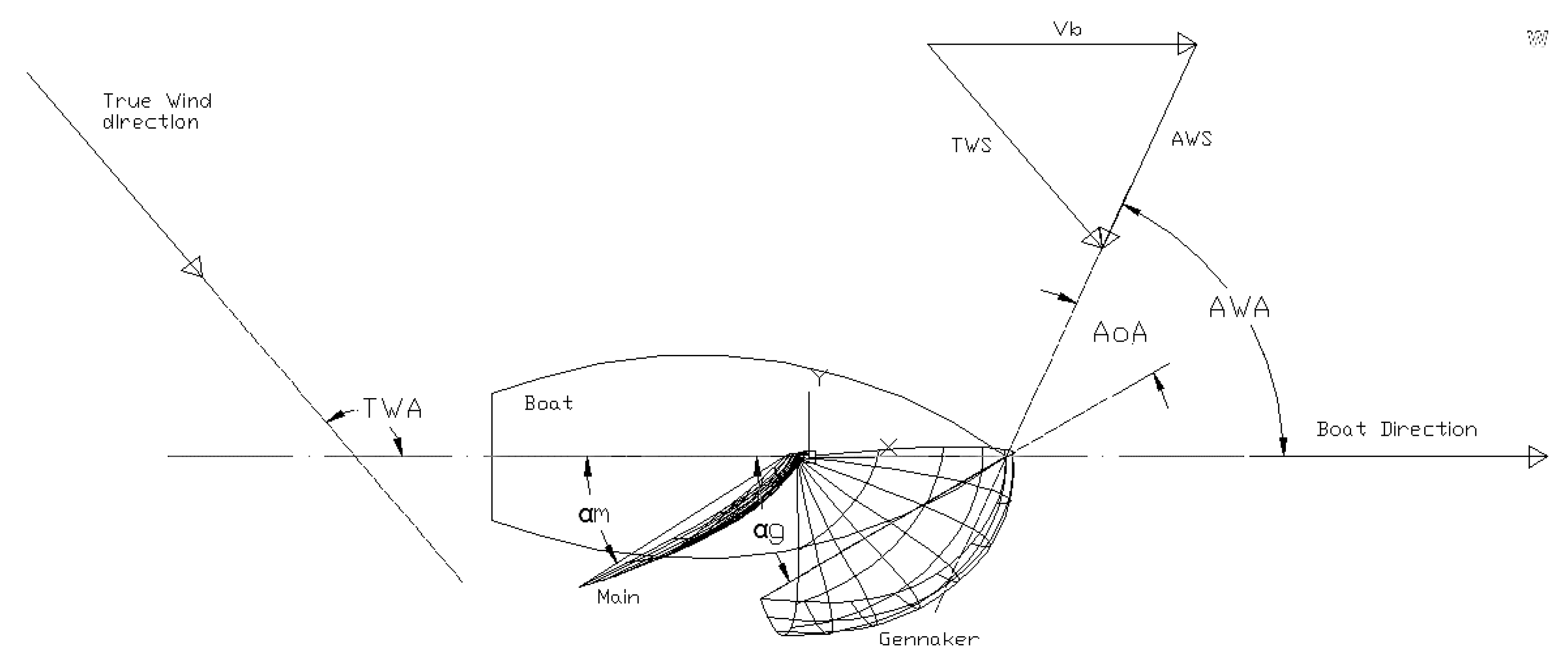
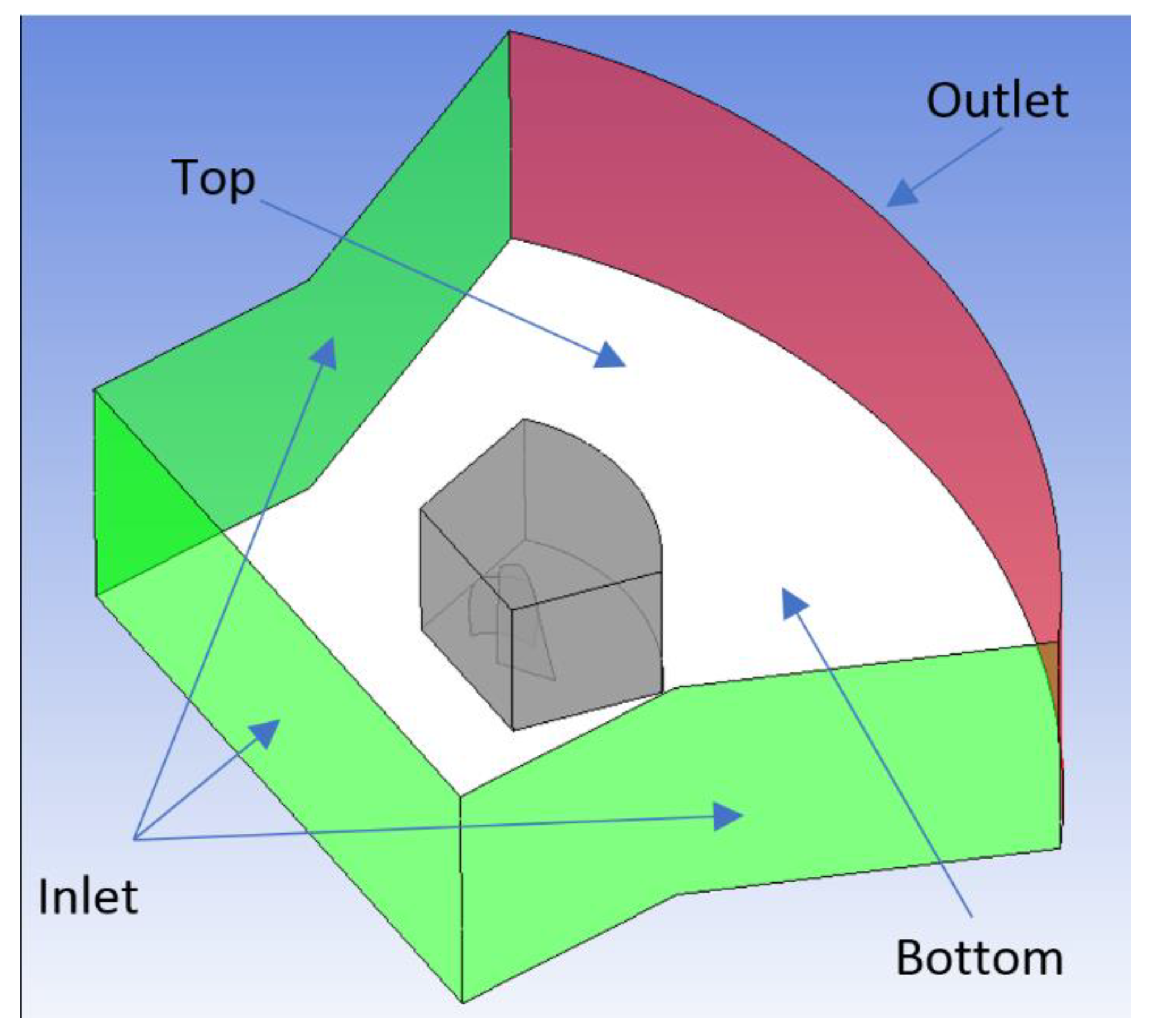
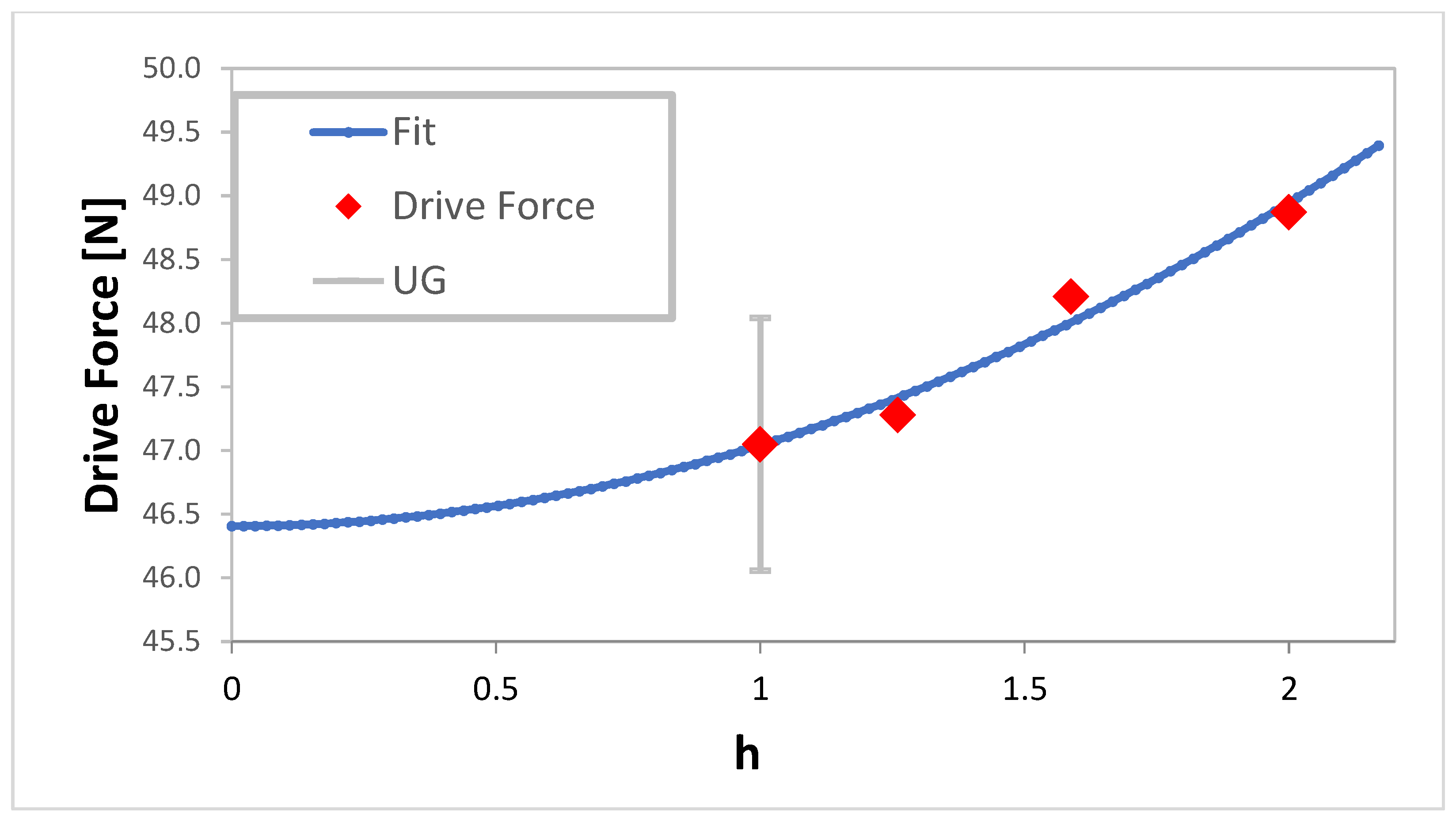

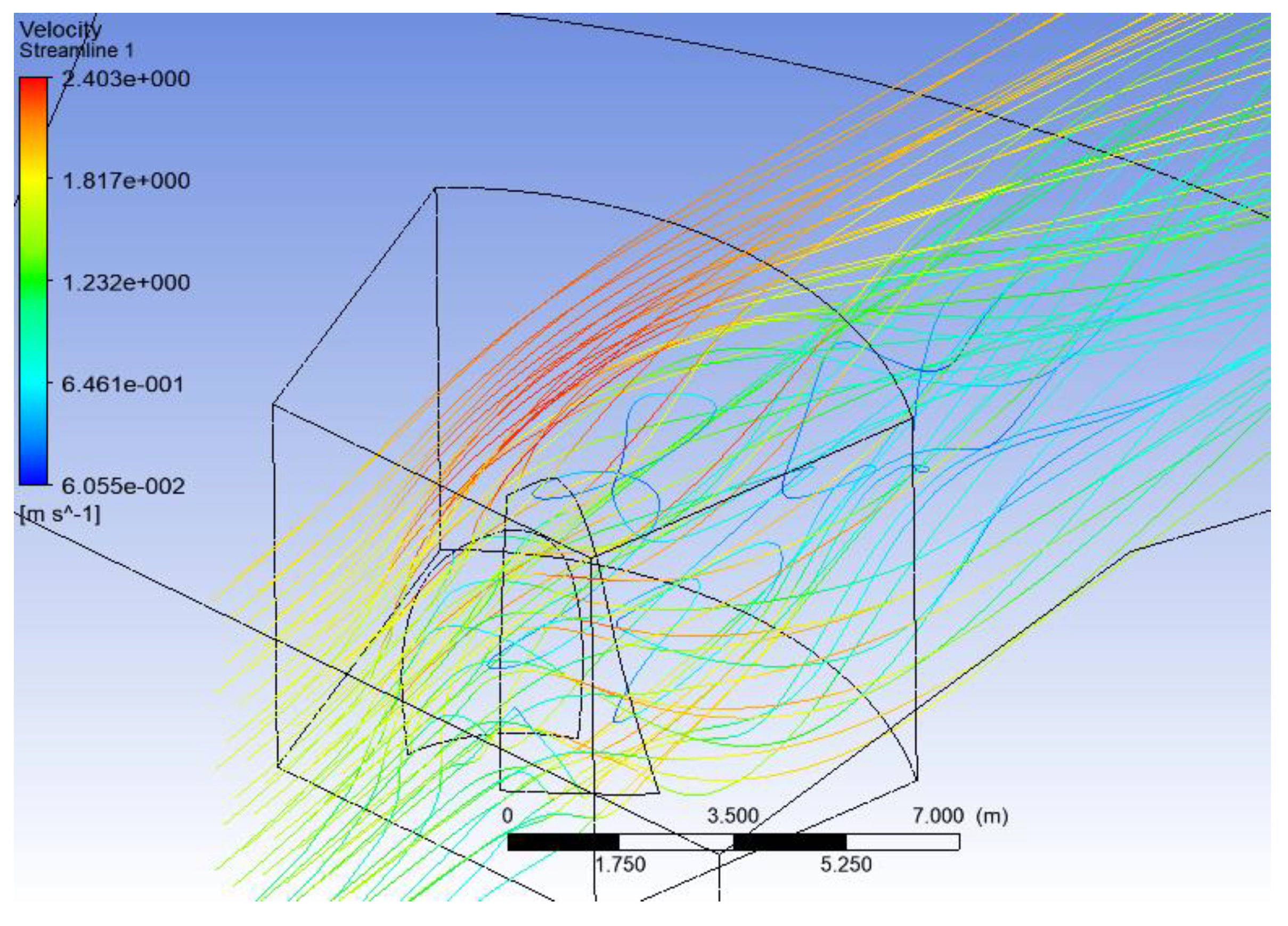
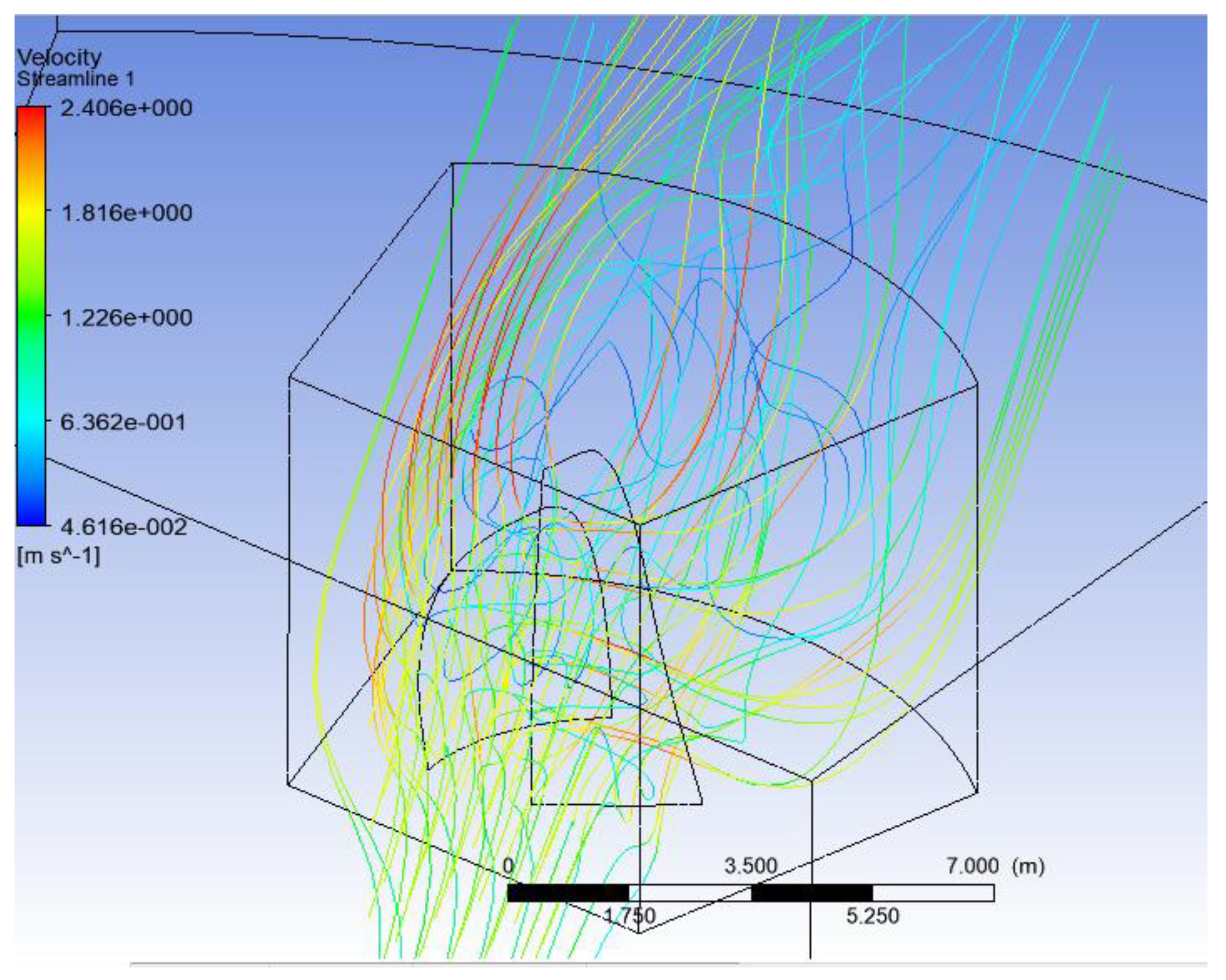
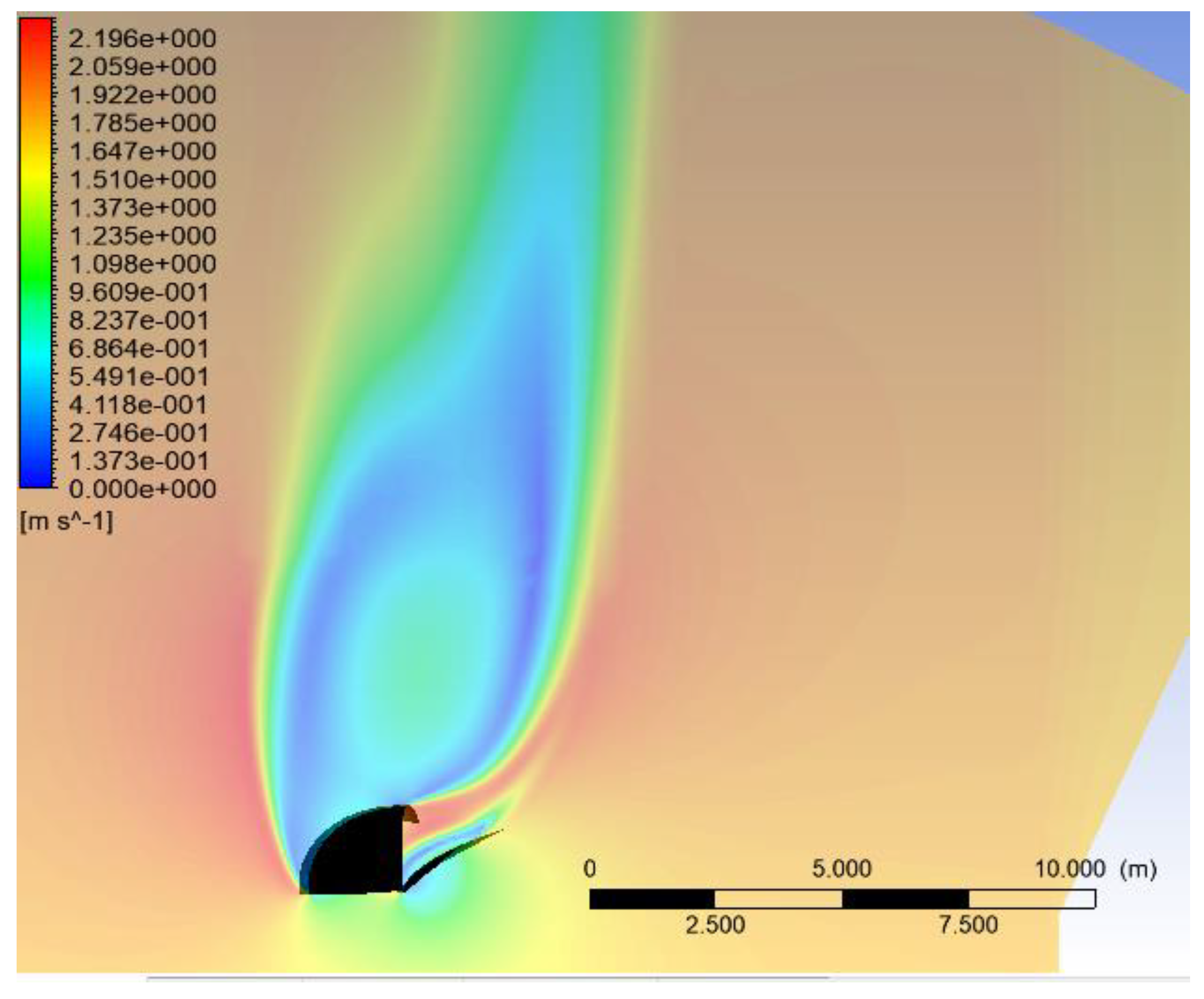
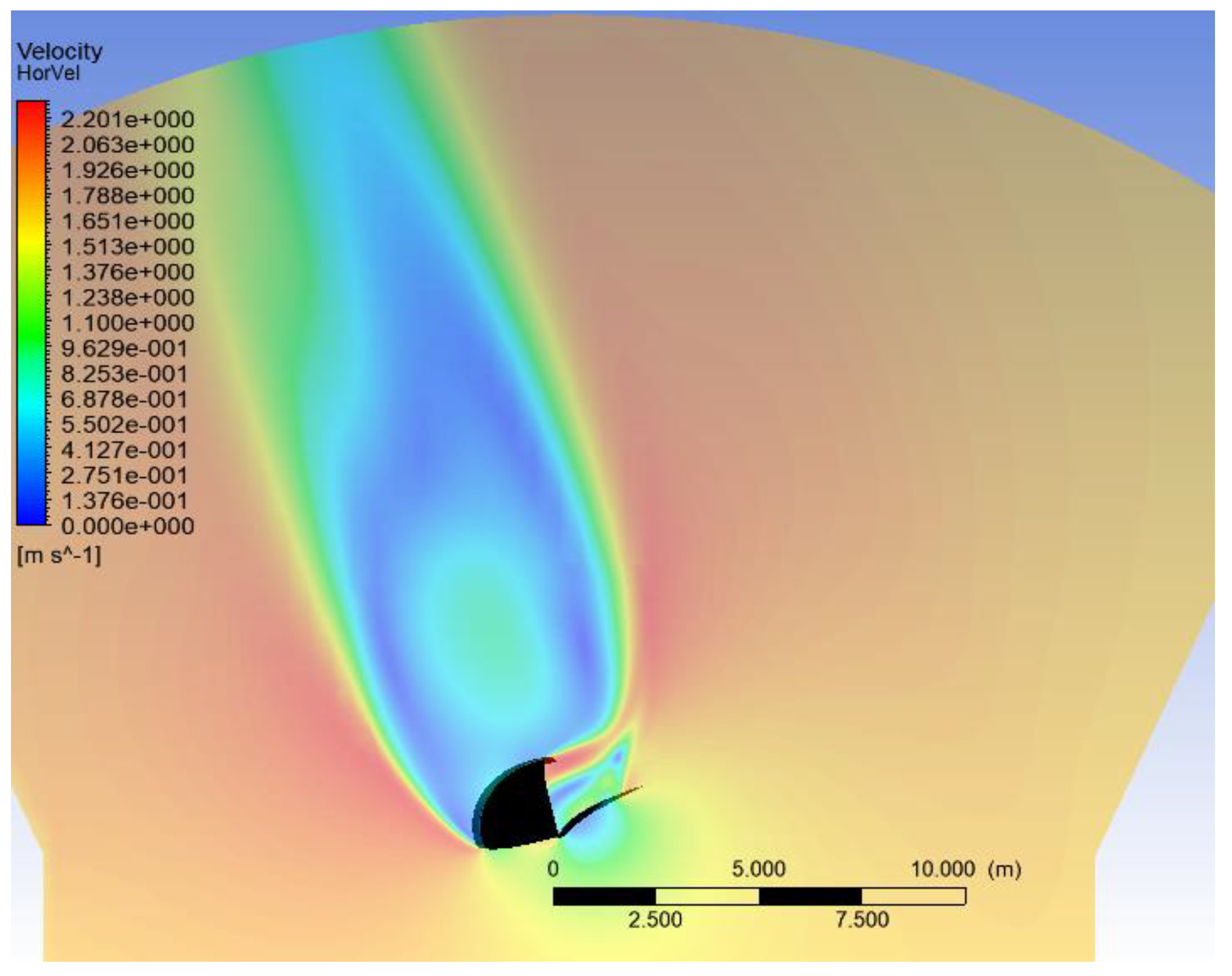
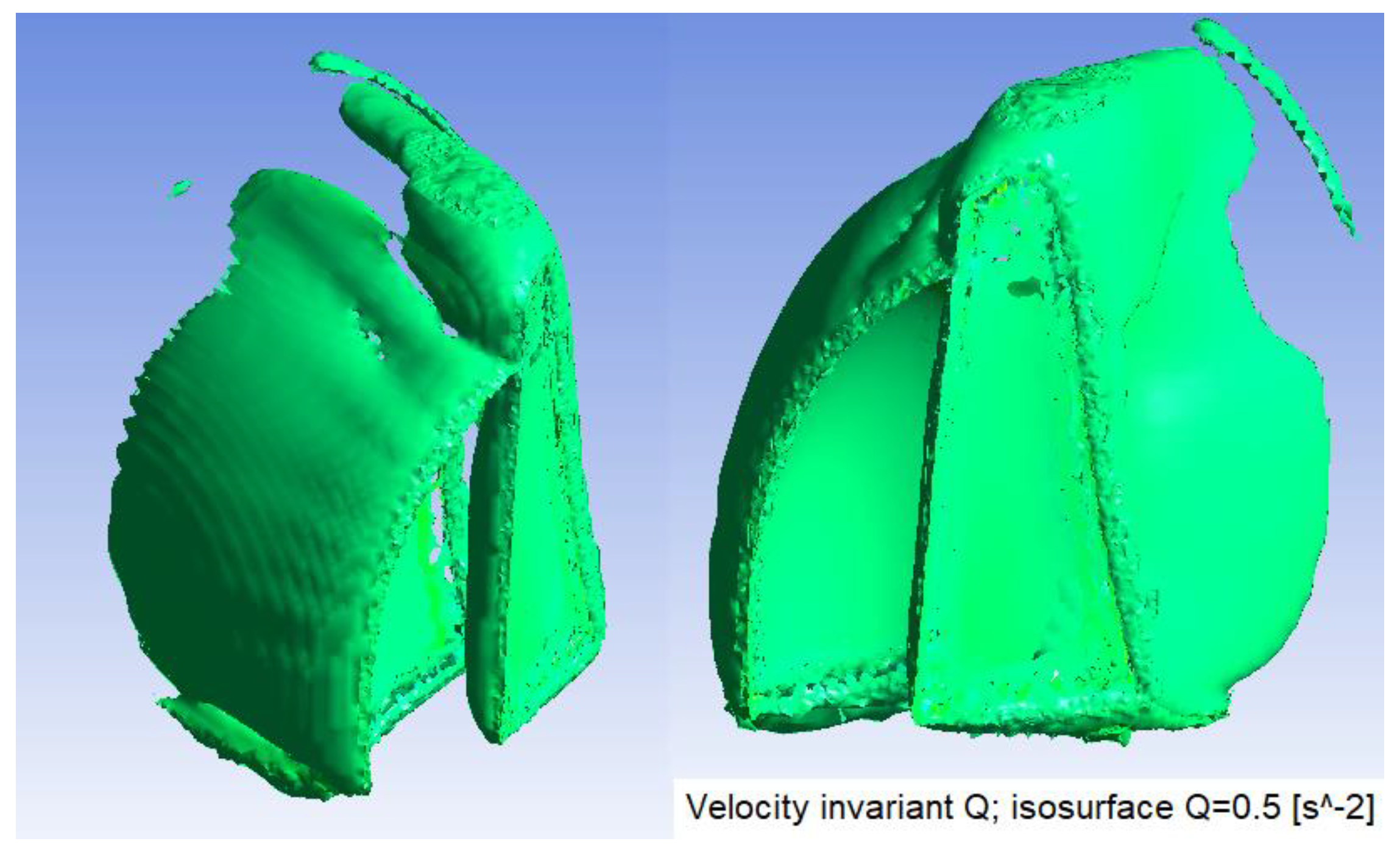
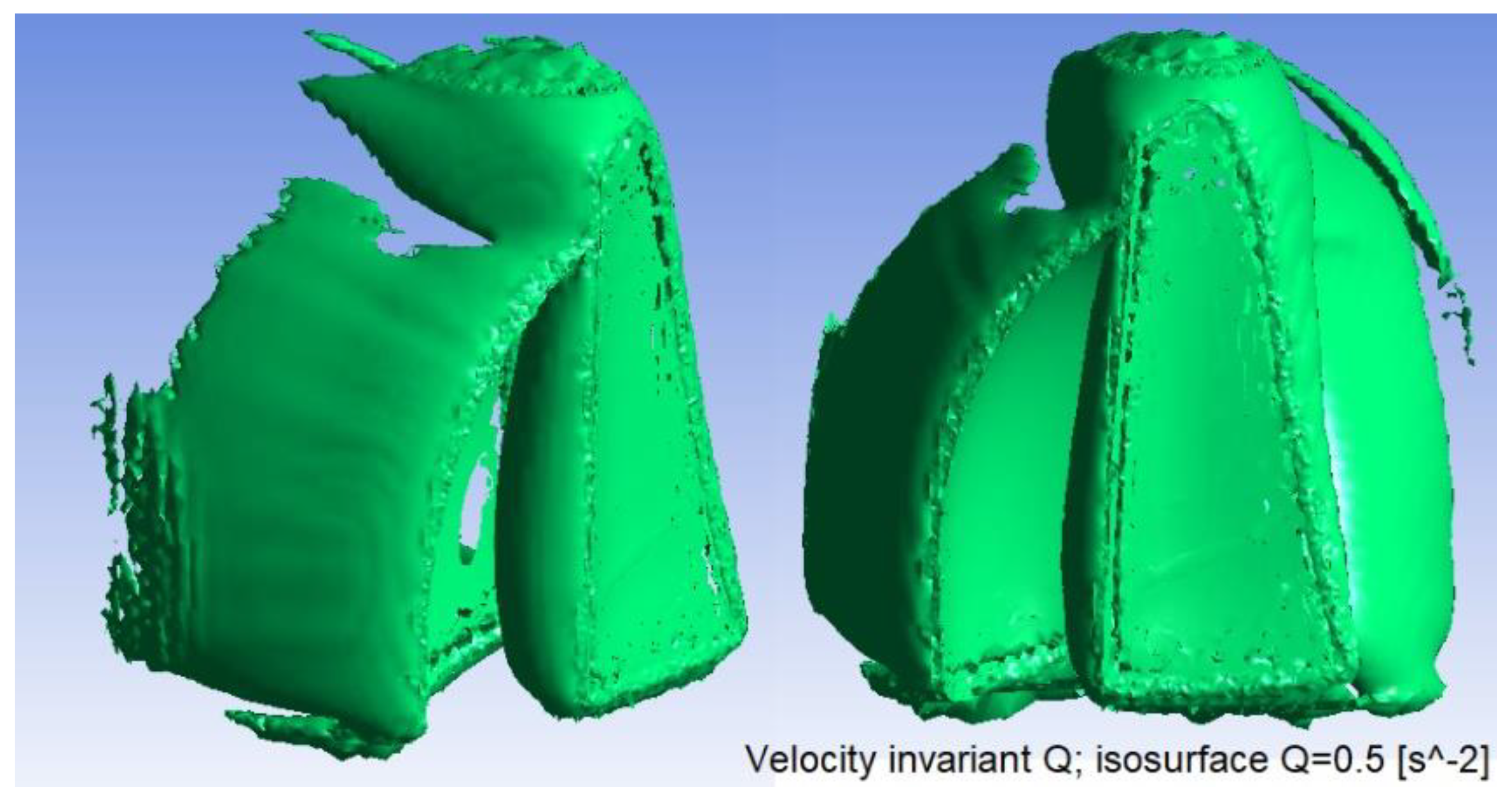


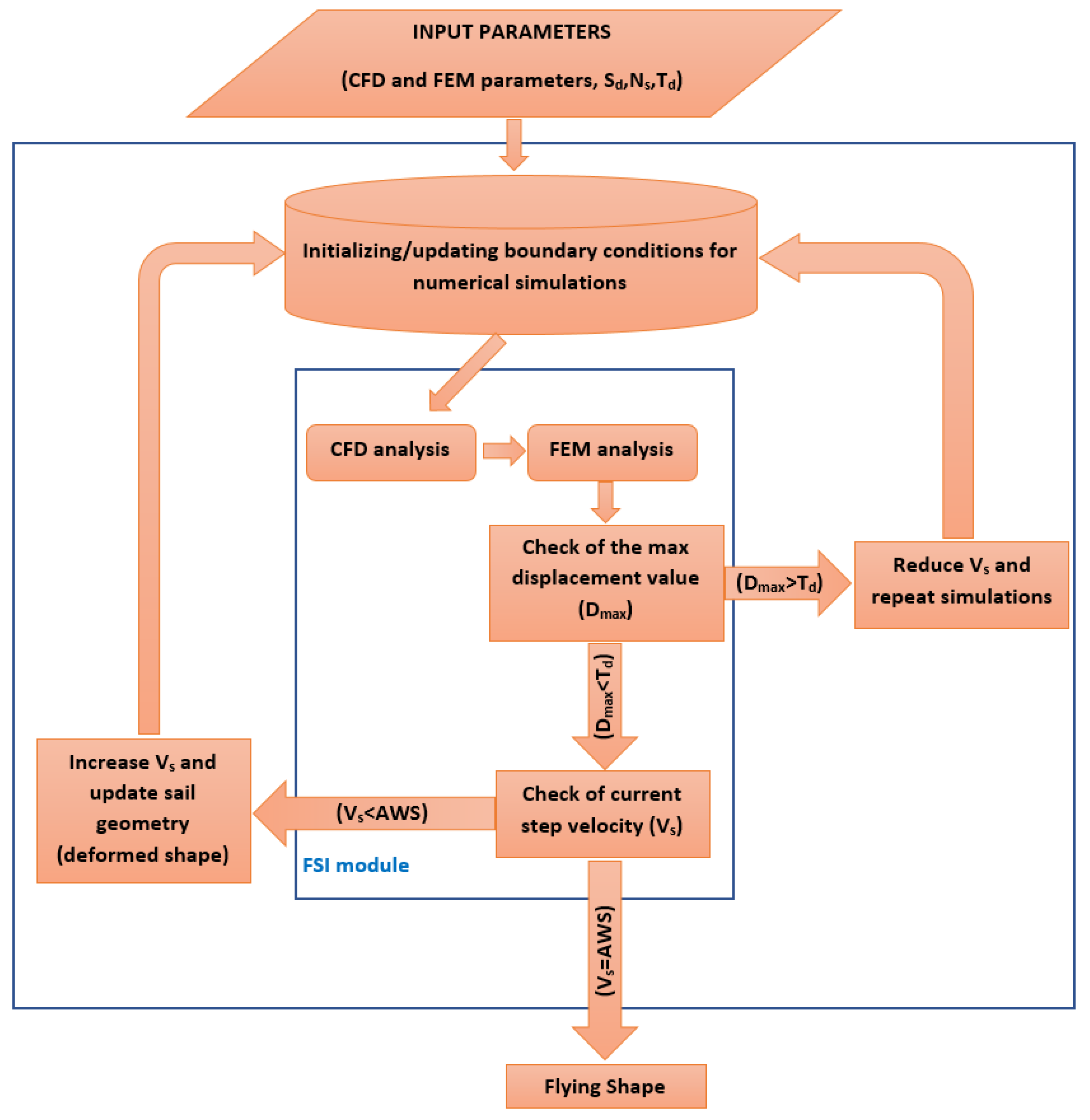


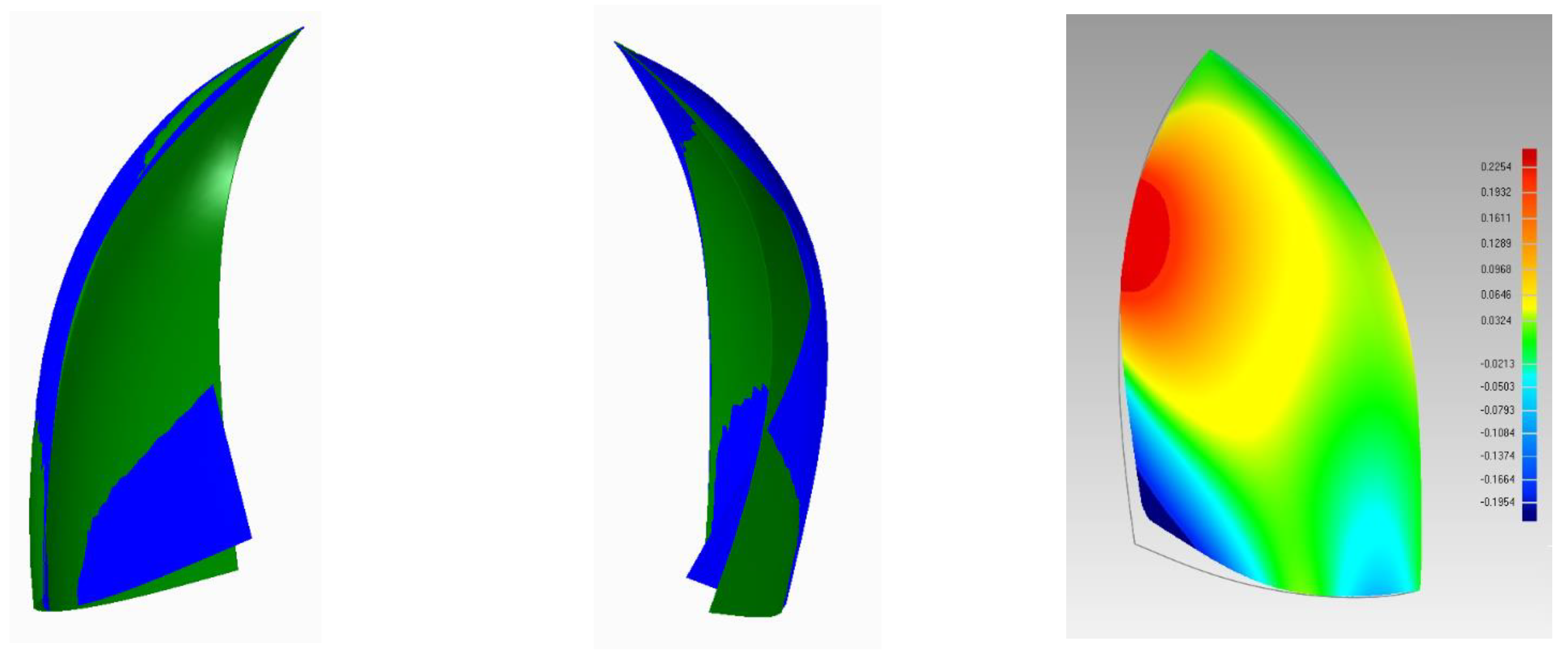

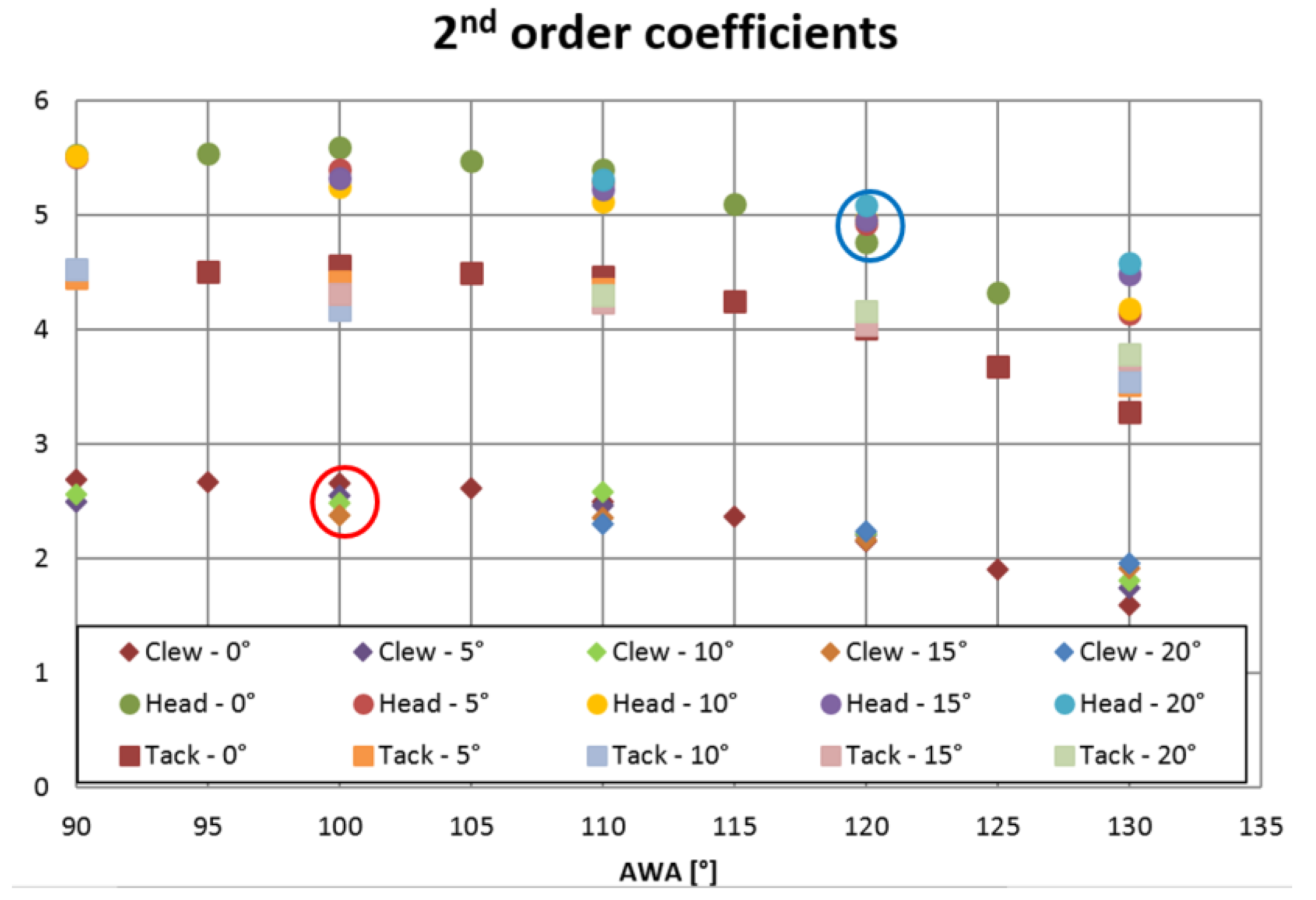

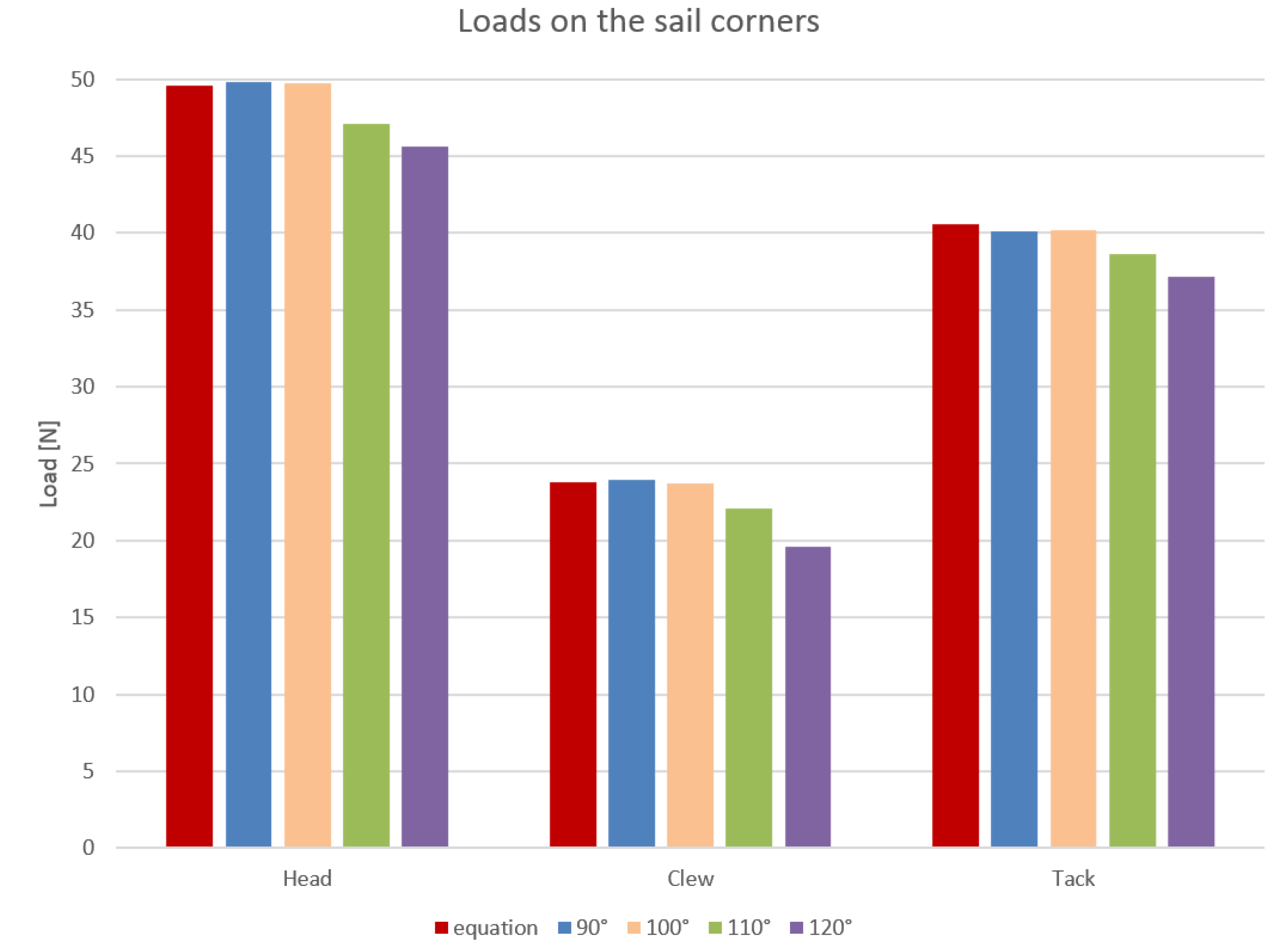
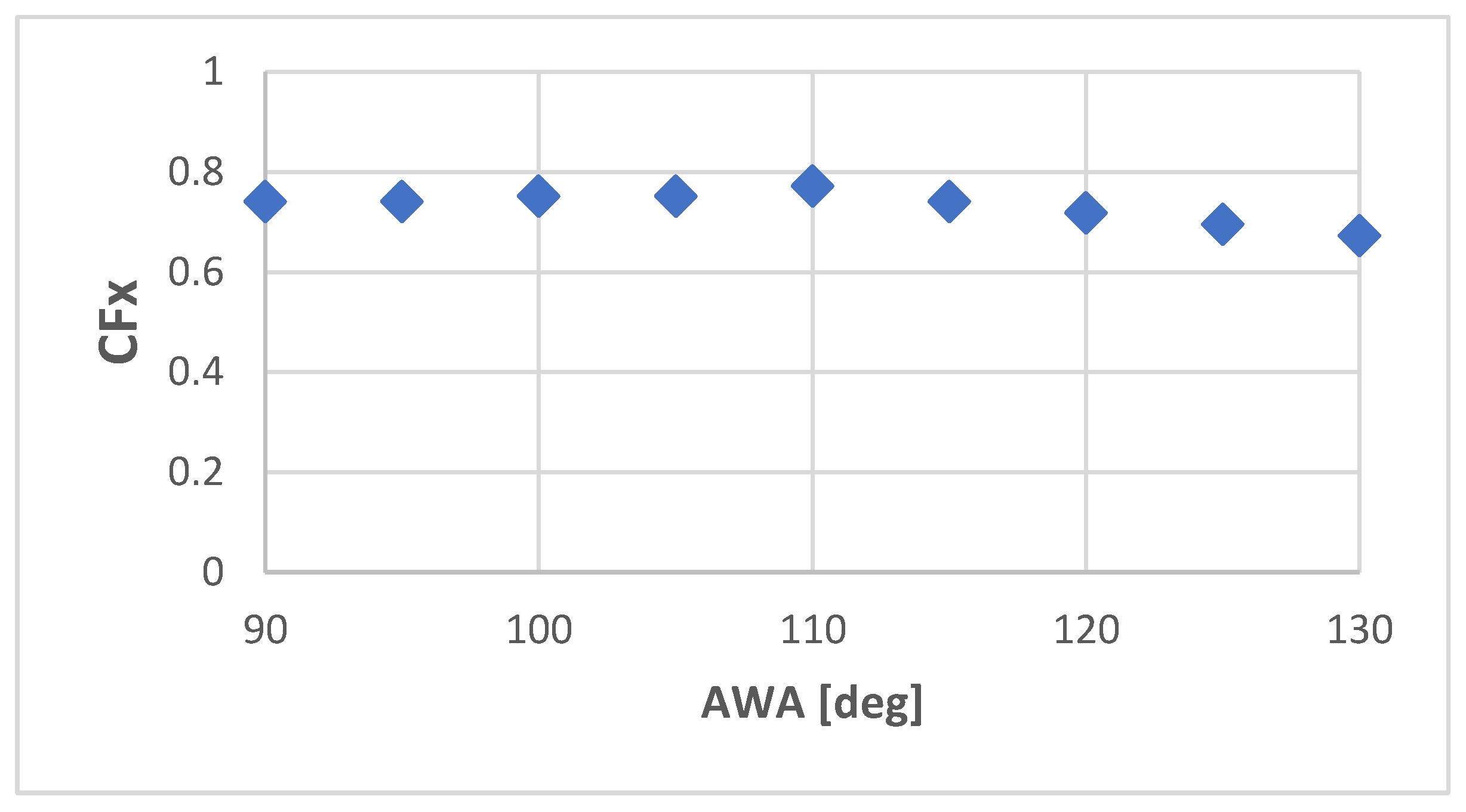
| Parameter | Unit |
|---|---|
| Apparent wind speed (AWS) | m/s |
| Apparent wind angle (AWA) | deg |
| Mainsail boom angle (αm) | deg |
| Downwind sail trim angle (Δαg) | deg |
| Inlet | Outlet | Top |
|---|---|---|
| 5 × Cm | 10 × Cm | 1 × Cm |
| Number of Cells | Drive Force [N] | h | UG [N] | UG% |
|---|---|---|---|---|
| 1,500,000 | 47.05 | 1.00 | 0.99 | 2.1% |
| 750,000 | 47.28 | 1.26 | 1.44 | 3.1% |
| 375,000 | 48.21 | 1.59 | 2.54 | 5.5% |
| 187,500 | 48.87 | 2.00 | 3.25 | 7.0% |
| Parameter | Value |
|---|---|
| Displacement threshold value (Td) | 0.035 m |
| Number of steps (Ns) | 5 |
| Sail thickness | 0.7 mm |
| Young’s modulus | 5500 MPa |
| Poisson ratio | 0.25 |
| Apparent wind speed (AWS) | 3 m/s |
| Apparent wind angle (AWA) | 90° ÷ 120° |
| Mainsail boom angle (αm) | 35° |
| Downwind sail trim angle (Δαg) | 0° ÷ 20° |
| AWA [°] | Clew | Tack | Head |
|---|---|---|---|
| 90 | 2.69 | 4.53 | 5.53 |
| 95 | 2.67 | 4.51 | 5.54 |
| 100 | 2.66 | 4.56 | 5.59 |
| 105 | 2.62 | 4.50 | 5.48 |
| 110 | 2.58 | 4.47 | 5.40 |
| Average values (CC) | 2.64 | 4.51 | 5.51 |
Publisher’s Note: MDPI stays neutral with regard to jurisdictional claims in published maps and institutional affiliations. |
© 2021 by the authors. Licensee MDPI, Basel, Switzerland. This article is an open access article distributed under the terms and conditions of the Creative Commons Attribution (CC BY) license (https://creativecommons.org/licenses/by/4.0/).
Share and Cite
Cirello, A.; Ingrassia, T.; Mancuso, A.; Nigrelli, V.; Tumino, D. Improving the Downwind Sail Design Process by Means of a Novel FSI Approach. J. Mar. Sci. Eng. 2021, 9, 624. https://doi.org/10.3390/jmse9060624
Cirello A, Ingrassia T, Mancuso A, Nigrelli V, Tumino D. Improving the Downwind Sail Design Process by Means of a Novel FSI Approach. Journal of Marine Science and Engineering. 2021; 9(6):624. https://doi.org/10.3390/jmse9060624
Chicago/Turabian StyleCirello, Antonino, Tommaso Ingrassia, Antonio Mancuso, Vincenzo Nigrelli, and Davide Tumino. 2021. "Improving the Downwind Sail Design Process by Means of a Novel FSI Approach" Journal of Marine Science and Engineering 9, no. 6: 624. https://doi.org/10.3390/jmse9060624
APA StyleCirello, A., Ingrassia, T., Mancuso, A., Nigrelli, V., & Tumino, D. (2021). Improving the Downwind Sail Design Process by Means of a Novel FSI Approach. Journal of Marine Science and Engineering, 9(6), 624. https://doi.org/10.3390/jmse9060624







